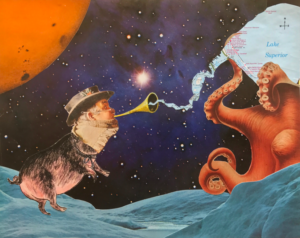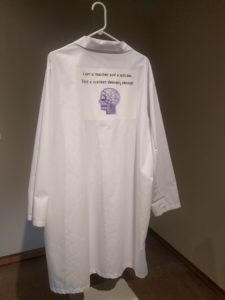On Tuesday, Sept. 5, Anastassiya Andrianova’s vision of a space for non-visual arts artists to show their work was realized when her exhibit opened at Flakoll Gallery at Renaissance Hall.
Andrianova, an assistant professor of English at North Dakota State and also an artist, knew of other faculty members not in the visual arts department who were also artists. However, their primary work as professors and scholars often overshadowed their art, making it difficult for them to showcase their work.
“My vision for this was to try to showcase and celebrate, as it states in the mission, the art of non-visual arts faculty,” Andrianova said. “As a painter and an artist myself who’s not in the visual arts department, I suspected there are others who are also doing interesting work.”
In total, there are six artists from three different disciplines and a variety of art mediums, including paintings, collages, paper art, photography and graphic art.

Anastassiya Andrianova describes Brady Bergeson’s works, including ‘Geological Formation of the Lake Superior Basin,’ as “whimsical.”
The exhibit starts with Brady Bergeson, a senior lecturer in English, and his collages. Three of his works are shown, works Andrianova describes as “whimsical.”
“To me, they promote a kind of joy and exploration and abstraction,” she said.
After Bergeson’s works, Deona McEnery’s three-dimensional butterflies, dragonflies and beetles are displayed in shadow boxes. Small but incredibly intricate, McEnery’s works almost look as if they could be real, pinned insects.
The main focal point of the exhibit is on Adam J. Goldwyn’s photographs from an archaeological site in Dara, a refugee camp in Turkey.
Goldwyn, another professor of English, has three images represented in the exhibit, all of which Andrianova carefully hung.
“The images, I think, are really quite extraordinary,” Andrianova commented. “I’ve highlighted ‘Minnie Mouse Girl of Dara’ and made her the focus of the three because of the way she draws you in with that gaze. But also, the juxtaposition between the poverty surrounding them and the joy and the excitement in these kids. The wonderful smiles in the foreground, and the washed out, deserted landscape in the back.”
At the far corner of the exhibit, hanging hauntingly from a hanger, is a lab coat emblazoned with a patch on the back that reads: “I am a teacher and a scholar; not an information delivery service!” Kenneth Lepper, a geosciences professor at NDSU, and his partner, Jennifer Lepper, an anthropology and earth science professor at MSUM, created the piece together.
“He does call it the ‘tweed blazer equivalent for science faculty,'” Andrianova said. “And he does wear it to class, I’m told. He has a couple of them. I said, ‘You know, you’re going to need to give this to me for three weeks,’ and he said, ‘That’s okay, I have another one.'”

Ken Lepper and his partner, Jennifer Lepper, co-created the lab coat that bares a message Andrianova strongly believes in.
Andrianova also likes the coat’s message: “I think it’s one that needs to be said, particularly these days where the arts and education are receiving less funding. There’s a corporate move toward computerization and everything is available online. But we (professors) are still valuable. We’re not just delivery services. We are thinkers; we are creative thinkers; we’re innovative thinkers. I love that message because I think it applies not just to the scientists, but also to the arts and the humanities.”
After the Leppers’ piece, microbiology professor Birgit Pruess has two photographs on display. The first, “Copper is the Sun,” superimposes the photo of Copper, a horse from Theodore Roosevelt State Park, onto the photo of a sunset from Fargo.
Pruess’s second piece is a photo of the center of a sunflower. Andrianova said that this was one of the first photos Pruess took when she moved from Germany to North Dakota.
“She describes it as providing the warmth and the sun that you need from the winter months,” Andrianova said.
The final four paintings of the exhibit are by Andrianova. The first two are more figurative, featuring realistic portraitures of images from Andrianova’s home country, Ukraine.
“I was drawn to a folkloric, kind of Ukrainian subject,” she said. The first image is of a peasant woman: “She’s standing in front of a traditional Ukrainian rural house with a rushnyk, which is a traditional Ukrainian embroidery. You greet people with that and a piece of bread with some salt on it when you have somebody come over to your house. That’s what she’s doing here, welcoming people to come over.”
Beside her is an old white man playing a bandura:
“This is drawn from a photo I took in Kiev,” Andrianova explained. “He does have an Internet presence. He’s a bandura player who’s always there at St. Sophia Church, just playing his instrument and people put him up on YouTube. I like both the traditional connection, but also the modern side of things.”

Andrianova’s abstract works, including ‘Sunken City’ and “The Morning After the Apocalypse,’ represent her feelings of the current state of the country.
From her more realistic portraits, Andrianova moves into the abstract. Her first piece, “Sunken City,” was painted closely after the inauguration.
“I was feeling very down and depressed and contemplative,” she said. “I’ve been trying to make my paintings more uplifting and lighter, but the black shades kept coming in.”
Her second piece (or rather, her second two pieces) is entitled “Morning After the Apocalypse.” Andrianova laughed a little when she said, “I guess I’ve been kind of working out some conflicted emotions.”
She continued, saying seriously, “It’s just that I’m very concerned for the status of the arts, particularly in this current administration. There have been projected cuts for the National Endowment for the Arts and the National Endowment for the Humanities. I think when I work as an artist, I’m very aware of those, and my paintings have gotten a little darker. There’s always that bright, neon orange that reminds you of some hope ahead. I’ve been contemplating that.”
“There is a larger political message, not just to the paintings, but to the exhibit, too,” she said. “Thinking of these cuts to the humanities at the federal level, but also these cuts at the state level, particularly hitting the arts and the humanities. This is a way to remind people of what scholars do, both in the classroom and outside of the classroom, should make us equally valuable. Because when people think of teachers, they think of us working in the classroom. But a lot of us are really hard workers and researchers, and we do service to the university, but we also do a lot of other innovative, creative work that deserves a venue and deserves some interest and celebration and recognition.”
Overall, this has been a learning experience for Andrianova. She describes learning about how to engage the viewer not only with the works, but also with the space.
“I’ve definitely learned a lot about optics and lighting and choices about how to organize this space,” she said. “That’s definitely interesting thinking about the audience and how to engage the audience and how to make this a worthwhile experience.”
Andrianova is open to the exhibit becoming a yearly event and hopes that if it continues, there will be more faculty who come forward to share the work they do outside of their classrooms.
The exhibit will be open until Sept. 22, with an opening reception Friday, Sept. 15 at 3 p.m. If you would like to become involved in the exhibit, contact anastassiya.andrianova@ndsu.edu.
